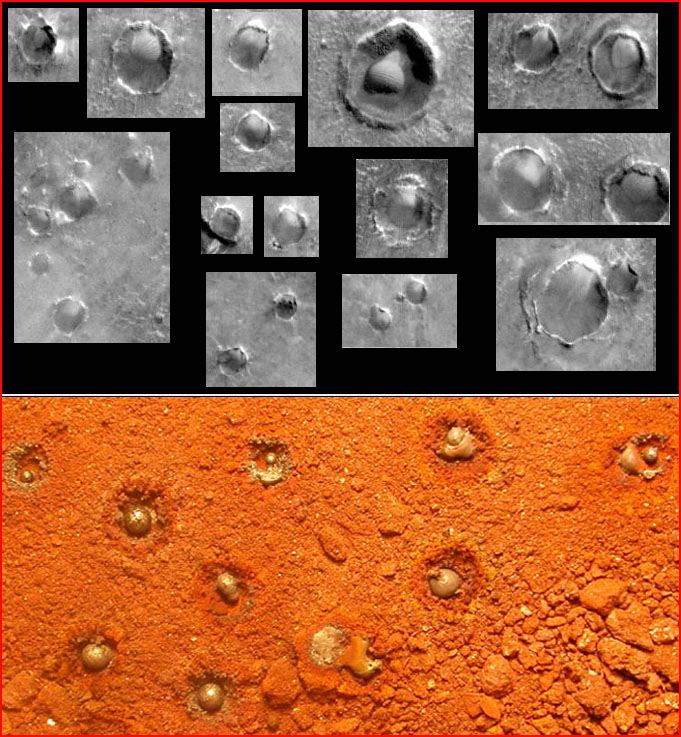
home •
about •
essential guide •
picture of the day •
thunderblogs •
news •
multimedia •
predictions •
products •
get involved •
contact

Credit: NASA/JPL/Malin Space Science Systems
pic of the day
archive
subject index
abstract
archive
Links:
Society for
Interdisciplinary
Studies
Mar 29, 2005
Domed Craters on Mars
Large craters on Mars contain mysterious spherical domes. The objects bear a striking similarity to the spheres and craters in Dr. C.J. Ransom’s electrical discharge experiments.
No body in the solar system will add more to our understanding of planetary history than the planet Mars. In recent years cameras aboard the Global Surveyor, the Mars Odyssey, and ESA’s Mars Express have generated thousands of high resolution images of the Martian landscape. And for more than a year now two rovers on Mars, Opportunity and Spirit, have provided extraordinary close-up views of the surface.
In recent Pictures of the Day we have suggested that many of the most profound surprises coming back from Mars—those producing the greatest strains on prior interpretations of Martian geology—are due to the failure of a theoretical perspective. Something is missing in standard analyses of Martian surface features.
The authors of this page are convinced that the most pressing need in planetary science is for experimental work on electrical scarring. It is essential that science explore electricity’s power to sculpt a planet’s surface. To underscore the explanatory potential of electric discharge we have noted the laboratory work of Dr. C.J. Ransom, who produced counterparts of the Martian “blueberries” through a simple experiment.
But this is only the first step in what must become a major commitment in the planetary sciences. Ransom’s work has profound ramifications for the larger picture of Mars. One of the well-known features of electric discharge is its scalability—what occurs on a small scale also occurs on larger scales. And there is reason to believe that on Mars the little spherules imaged by the rover Opportunity have an analog at a much greater scale. Our orbiting cameras have found numerous craters with domes or spheres resting within them. All of the pictures of domed Martian craters in the upper picture above are taken from a single high resolution image by the Global Surveyor—
http://ida.wr.usgs.gov/html/m15012/m1501228.html
In simple appearance craters and “domes” look surprisingly similar to craters with embedded spheres in Dr. Ransom’s experiment (lower pic). In contrast to the rover blueberry images, the “domed craters” range in size from kilometers in diameter down to a hundred meters or less, with many indications of others just beyond the resolution of the cameras.
At the present time, Ransom’s electrical discharge experiments have provided the only fact-based explanation for these anomalous formations. It is only reasonable, therefore, to ask if the “blueberries” and the domed craters were produced by the same electrical force, acting on widely different scales. We must also emphasize that, from the electric vantage point, the agent that created the domed craters would have left its signature in other ways as well. For this reason, we encourage the reader to access the full image at the URL given above, and to note the extraordinary features present in the same geologic neighborhood. We shall take up these contexts imminently.
The domed craters on Mars are another reason for planetary scientists to revisit issues of solar system history, including possibilities long excluded from scientific discussion.
EXECUTIVE EDITORS:
David Talbott, Wallace Thornhill
MANAGING EDITOR: Amy Acheson
CONTRIBUTING EDITORS: Mel Acheson, Michael Armstrong, Dwardu Cardona,
Ev Cochrane, C.J. Ransom, Don Scott, Rens van der Sluijs, Ian Tresman
WEBMASTER: Michael Armstrong
Copyright 2005: thunderbolts.info